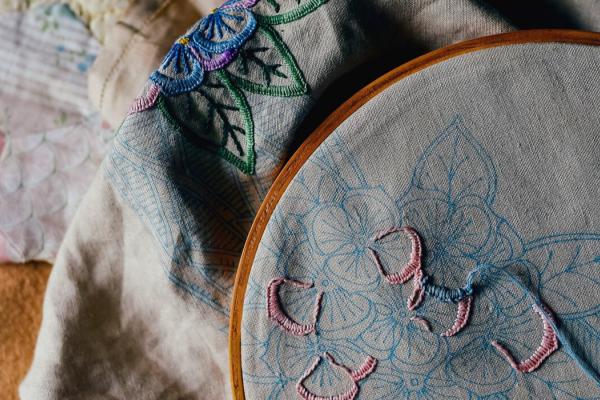MY MEDIUM OF choice is usually words. My activism often takes the shape of a column, sermon, or talk, a march or protest, lobbying representatives, attending meetings “to be a voice,” and voting. But recently, I took on activism with a needle and went back to a hobby of mine to bring my words to life: cross-stitching.
Through the miracle of social media, I was connected to Alicia Watkins—who offers back-stitched pithy sayings, and images of microbes, through her Etsy shop, including a pattern to stitch “Nevertheless, she persisted” on a tiny piece of fabric. Tiny stitches formed the letters and communicated what many women across the globe do, through a type of art form that is often disparaged as “women’s work.” Watkins and I are not alone. Shannon Downey of Chicago calls the activity “craftivism,” and through it she raised more than $5,000 in November 2016 to combat gun violence.
The irony is not lost on me. It’s actually what I love about needlework. Textile art, embroidery, sewing, darning—across time and space they have been women’s work, girls’ work, the work of the poor. Nowadays we can sell the work online and get paid through PayPal, never actually connecting in real life, not even through a middle-person. But I was taught to sew because clothes and socks were not as disposable as they are now, 40 years later. My mom showed me not only how to sew a button back on a shirt, but also how to carefully repair holes and stitch up small runs in my pantyhose, sealing my work with a touch of clear nail polish. I thought of those lessons yesterday as I worked on finishing a commissioned cross-stitch piece, while my spouse threw out a pair of socks with holes in them.
I did not retrieve the socks from the garbage. I just sat there stitching the word “vulnerable,” once again catching the irony. My “craftivism” would not save the pair of socks and keep them from the landfill. Instead I put my finished work of the seven words allegedly forbidden by the Trump administration for use in official papers of the Centers for Disease Control (“vulnerable,” “entitlement,” “diversity,” “transgender,” “fetus,” “evidence-based,” and “science-based”) in a thrift-shop frame and sent it along.
I’m still thinking about the socks that were thrown out, because my life experiences and my activism continue to shift and change, one informing the other. There was a time in my family’s life when pantyhose—pantyhose!—were repaired several times before a new pair fit in the budget. We weren’t activists. We were just poor immigrants who couldn’t afford to replace things just because they broke down, got a hole, or fell out of fashion. We were the people I want to think I am fighting for instead of fighting with. We engaged in recycling, repurposing, thrifting, and living minimally not because it was activism but because life depended on it.
As I get ready to fulfill two more commissioned pieces, I’m beginning to wonder about how I—we—need to spend more time reflecting on the past, to see if there are lessons we have learned and actions we’ve engaged in that don’t fit neatly into our categories of activism and social justice work.

Got something to say about what you're reading? We value your feedback!

